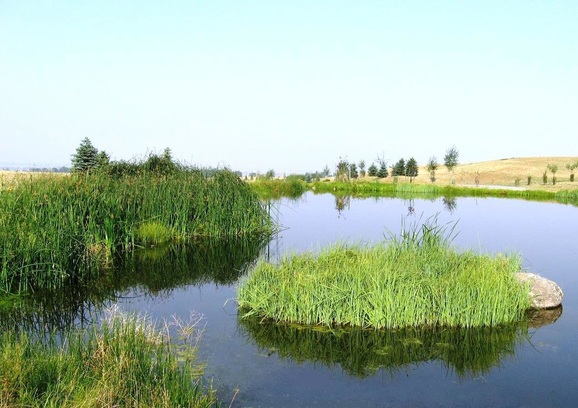Author Unknown

Pond Information Article
Successful long-term pond and lake management requires a “Holistic Approach”. Holistic Management is an objective driven means of manipulating aquatic ecosystems using environmentally responsible materials. Holistic pond management involves accessing the factors that are occurring within the pond and using this information to implement the most appropriate management program. The three primary tools are aeration, bio-filtration, and beneficial microbes. In this article, we will briefly review the three components and their use in pond and lake systems.
Aeration
Aeration provides a life-giving breeze within the pond. Of the available types, bottom diffused aeration provides the most efficient operation in ponds deeper than 8 feet deep. Oxidation of bottom material accelerates decomposition, reduces production of hydrogen sulfide gas, and reduces the amount of black material on the bottom. Also, decomposition is highly accelerated (20-30 times faster) under aerobic conditions. Aeration also provides movement within the pond. The movement enhances the role of periphytic filtration by passing water through the artificial substrate. Finally, aeration disrupts the thermocline, permitting fish to inhabit deeper waters. Some concern arises that the cooler layers of the pond will no longer be available for the fish to use. However, under periods of anoxia (no oxygen), the fish are not able to tolerate the low dissolved oxygen levels in the cooler layers. In most cases, fish will be better served to provide them with more area to inhabit rather than being concerned with disrupting the temperature profiles.
Beneficial Microbes
Beneficial microbes or bacteria are a formulated blend of organisms designed to consume reactive nutrients and organic muck. These blends contain additional micronutrients and enzymes that enhance the natural process already occurring within your pond. In some situations, the microbes can actually enhance the transfer of nutrients to your fish by optimizing the food chain. An intact food chain allows more efficient transfer of nutrients up the food chain. For those who are fertilizing your lakes to obtain optimal production, the use of beneficial microbes can decrease the amount of fertilizers needed.
Here’s how: much of the fish waste, dead algae, tree leaves, etc. accumulate on the bottom of your pond. This represents a large sink of nutrients that are mostly unavailable for fish growth in a short time frame (growing season). Adding beneficial microbes can convert much of this organic material into more usable forms that are consumed by rotifers, daphnia, and protozoan. The result is less fertilizer added and more fish production.
Each of the three primary components within holistic management (bottom diffused aeration, biofiltration, and beneficial microbes) plays a role in proper pond management. When used in conjunction, these tools allow holistically aware managers the ability to establish a healthy water resource. Although seemingly simplistic, it is important to realize that just tossing these materials into a pond will not necessarily solve all of the problems. Also, the order in which these materials are used in the pond is also critical. Age, nutrient loads, and organisms influence the management implemented. Therefore, experience and a strong ecological background are necessary to optimize the effectiveness of this management approach.
So, how do I properly maintain my pond?
- Set goals & objectives for your pond. Do some research and determine the feasibility of your goals and the time required to reach the desired outcome. You can never reach your goals if you don’t set any.
- It is important to realize that no magic bullet exists when managing a pond. With such a diverse system, it is nearly impossible to find a single solution that positively influences every component of the system. Therefore, management must consist of several components that work in conjunction to promote a healthier system.
- Determine the cause of your problem. Dense, filamentous algae is not the problem of a poorly managed pond, it is only the symptom of an underlying problem. Nutrients that have accumulated within your pond are the problem. This extends to managing your fish as well. Stunted bass is not the problem but a symptom of poor environmental conditions, limited forage, etc
NUTRIENTS. You must manage nutrients. Nutrients can be you friend or foe depending on your goals. This could require changes in the nutrient ratios for fish production or the physical removal of debris for swimming ponds. Regardless of your objectives, nutrients are the driving force and must be properly managed according to your goals.
- Get sound advice. Although the above principles seem straight forward, there are many technical and ecological factors that influence the effectiveness of holistic management. A quick analogy: essentially, your pond can be equated to a city; many individuals each performing their own job, yet influencing other individuals.
Now, try to keep the city functioning without any major difficulties. It can become difficult to make sure everyone is doing his job and keeping things in order. The same is true for managing your pond.
A final thought, it has likely taken several years for your pond to develop problematic growth. It is important to realize that holistic management will not correct pond problems in just a couple of days. However, as the system becomes more balanced, you will see changes occurring. In the long term, the system will improve and will not have the problematic algae growth that had once plagued the system. Keep these holistic principles in mind and you’ll be on the right track to a balanced pond.



You must be logged in to post a comment.